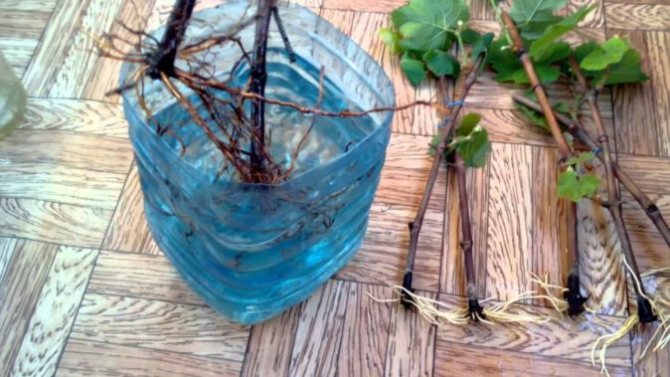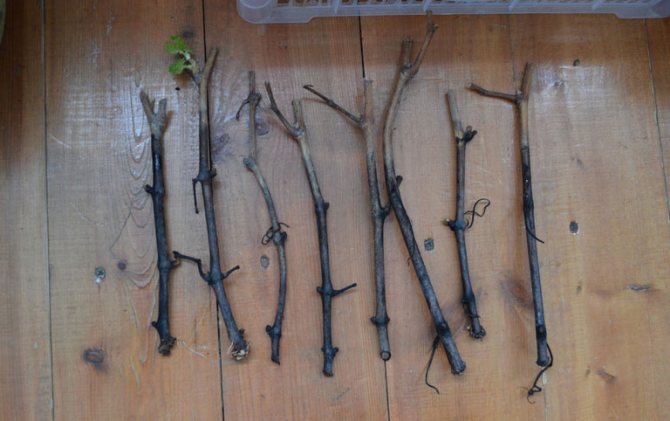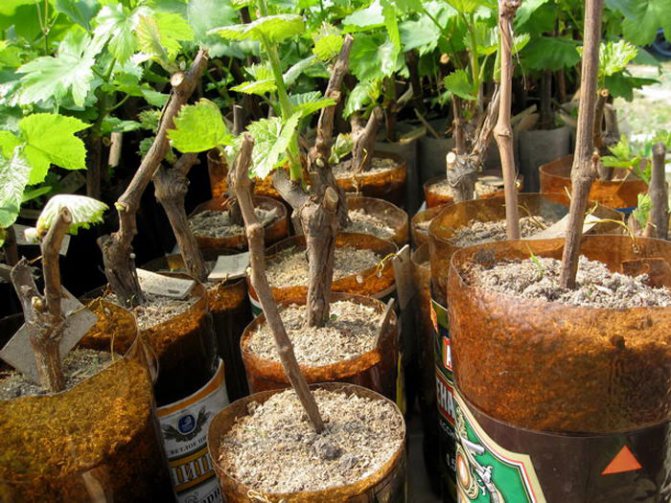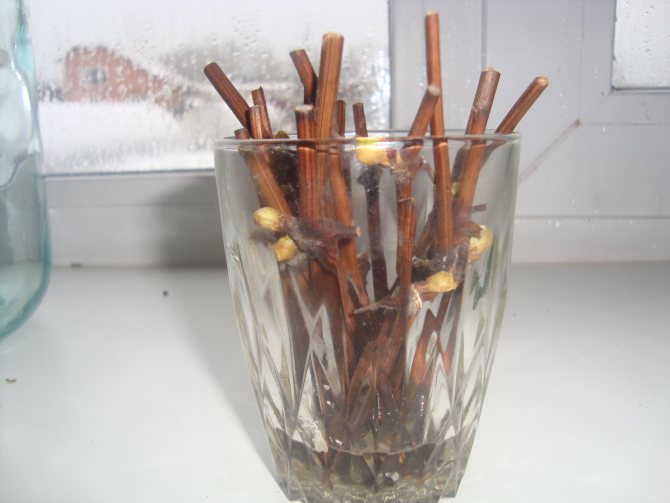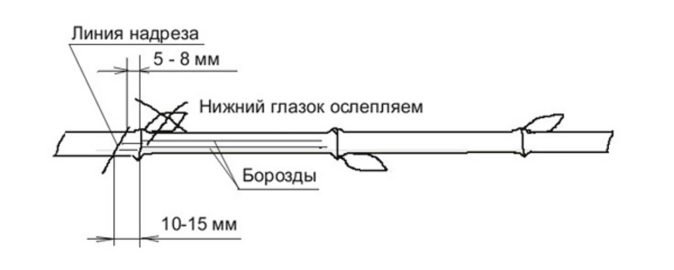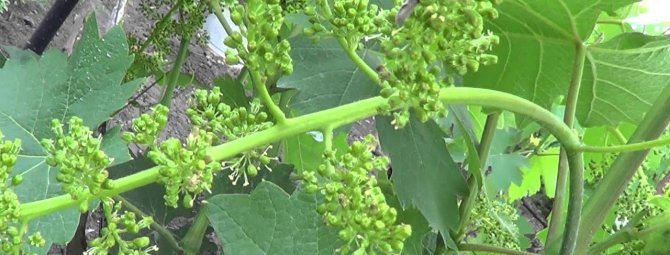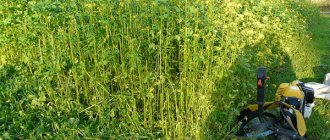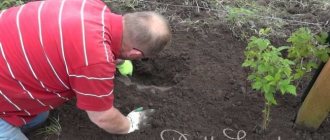Fruits and berries »Grapes
0
744
Article rating
Germinating grape cuttings allows you to get excellent planting material, which is much more stable than what is sold in the nursery.
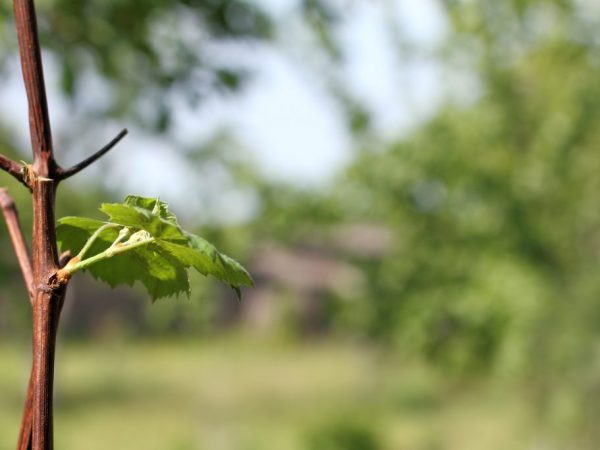
How to germinate grape cuttings
Array
When to start germinating grape cuttings
It is difficult to name a specific date when you can already get out and start germinating grape cuttings, because there are several very important factors on which your terms will depend specifically, namely:
- how long will germination take;
Note! If you can maintain optimal temperature conditions for germination, then the cuttings will be ready for planting much earlier than if they germinate under less suitable conditions.
- depending on the method of germination (if with kilchevanie, then it can be planted earlier; if without kilchevanie, then - 5-7 days later);
- when the warm season begins in your region (the earth warms up enough, at least up to +10 degrees);
- where you will plant (if in your personal plot, i.e. you live in a private house, then you can - earlier; if in the country where you visit 1-2 times a week, then later).
The fact is that in the event of returnable spring frosts, you must quickly respond and cover the seedlings, and this cannot always be done if your summer cottage is far from home.
As a result, from the moment of germination of cuttings to the planting of already vegetating grape seedlings, on average it takes about 2.5 months (70-80 days).
Features of cultivation in different regions
Chubuk is the same stalk, that is, part of an annual green or ripe vine shoot.
In industrial viticulture, green shanks are used as a reserve for the breeding of scarce varieties. They are harvested not in the fall (as ripe ones), but in the spring. Non-lignified cuttings from the lower or middle part of the shoot are suitable for reproduction. They are cut in such a way that on each one-eyed shank there is a kidney, leaf and stepson on the upper cut, and half of the knot on the lower cut. After that, the cuttings are immediately ready for rooting in the greenhouse.
For planting, drainage is poured on the bottom of the boxes, on top - wet sand with a layer of 4-5 cm. After planting the shanks, the boxes are covered with foil. The temperature in the greenhouse is maintained at 24-27 ° C, the moisture content of the sand is 90-95%. Overheating and wilting of leaves should not be allowed. After rooting, the cuttings are transplanted into the school.
Cuttings cut from the shoots of a fruit arrow or on replacement knots from the middle part of a one-year mature shoot take root better. Suitable parameters:
- the bark is brightly colored, smooth;
- at the point of attachment of the leaves, the color is brown and smooth;
- shoot diameter 7-12 mm;
- the ratio of the diameter of the pith to the diameter of the cutting is less than ½;
- shoot length 130-160 cm;
- the size of internodes characteristic of the variety.
It is these shafts that are used for early germination at home. The cuttings removed from winter storage are wiped or washed with a solution of potassium permanganate, dried and cut in such a way that from 1 to 3 eyes remain on each cuttings.
When cutting into 1 peephole, the lower cut is made oblique in the direction from the peephole, leaving 1/3 of the internodes, the upper one 1.5-2 cm above the peephole. In two- and three-eyed shanks, all cuts are made perpendicular to the axis, that is, straight.
The difference in the climatic conditions of the regions of amateur viticulture affects the ways of germinating cuttings and rooting of seedlings.
This region belongs to the zone of industrial viticulture. Climatic conditions make it possible to grow plants directly in the ground (cuttings or branches). Nevertheless, even here, amateur winegrowers actively use the rooting of shanks at home.
Belarus
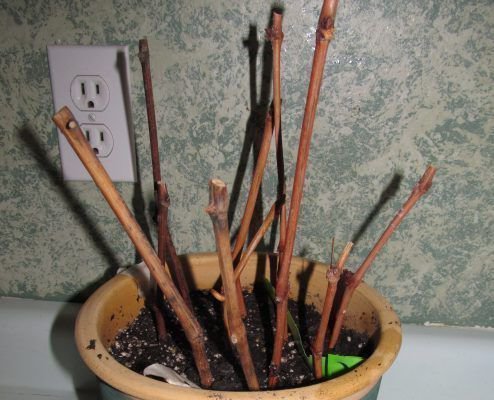

Conditions and terms for cultivation are standard with one caveat: obligatory preliminary rooting is required. It is carried out both at home and in greenhouses.
Moscow suburbs
Grapes are grown today not only in the Kuban, but also in more northern regions. In the Moscow region, so that the rooted seedlings do not stand in containers, the shanks are taken out of storage no earlier than March. The time of planting in open ground is calculated with an eye to return frosts.
Ural region
In the Urals, the main limiting factor for growing grapes is the early cold. This means that for planting you need to choose the earliest and frost-resistant varieties. To preserve heat and early warming up of the soil for cultivation, special trenches are made using the Ob technology. Shelter is a must in winter.
As for the germination of stems, rooted seedlings are in no hurry to be placed in open ground and kept in containers until autumn. For the winter, such first-year plants are stored or buried in, and the final planting is carried out the next year.
Read more: Variety of grapes lady's white red - description of varieties
- A large number of seedlings can be grown from cuttings;
- you can use, and not throw away shoots after autumn pruning;
- cuttings can be found from friends, exchange the desired varieties, easily sent by mail;
- to purchase grape cuttings is much cheaper in comparison with the cost of ready-made seedlings;
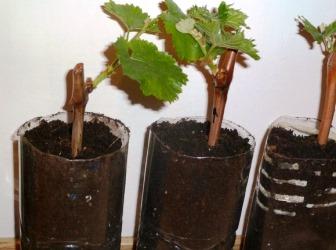

- cuttings rooted at home are already prepared for planting and will quickly take root in a permanent place.
Follow-up care
Regardless of the period of development of the plant, you must monitor the state of the soil, or rather, its fertility, acidity and, accordingly, moisture. Watering must be carried out during the first 4 days after planting, then the frequency should be reduced to 2 times a month. Compliance with this watering regime will accelerate the growth of the plant and strengthen its roots.


Further care of the grapes
Loosening of the soil must be carried out to retain a sufficient amount of moisture in it. To this end, gardeners mulch the soil between the bushes of growing grapes. For mulching, you can use different materials, such as sawdust. Experts recommend loosening the soil every 2 weeks. This frequency will be sufficient. And only 30 days after planting the cuttings in the ground, you can make a special top dressing, which you can purchase at any garden store.
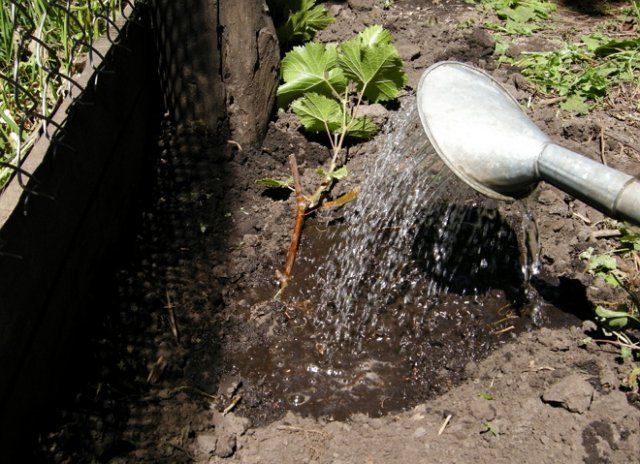

How to prepare grape cuttings for spring planting
Working with grape cuttings laid in the fall for storage, first of all, you should start with the following preparatory activities:
- Get the cuttings out of their storage area and simply put in the room, giving 2-3 days for adaptation at home;
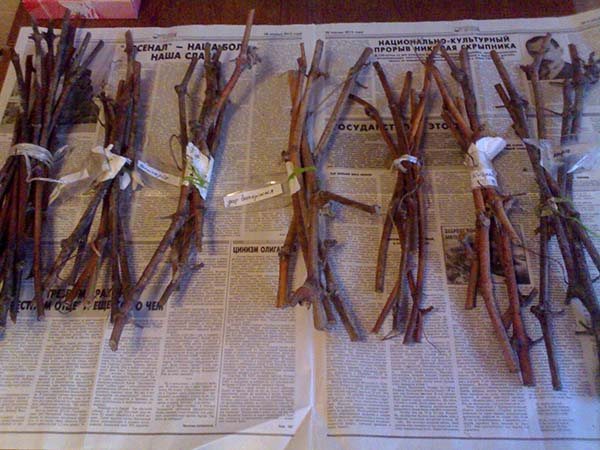

- Assess their condition, in other words, make sure they are of good quality. To do this, first carry out a visual inspection - there should be no darkening, stains, mold or other signs on the cuttings.
- If a the cuttings are slightly mildewedthen they should be rinse in a pink solution of potassium permanganate.
- Some growers regardless of the condition of the cuttings, they are disinfected (all in the same potassium permanganate solution for 30 minutes, and then washed under running water).
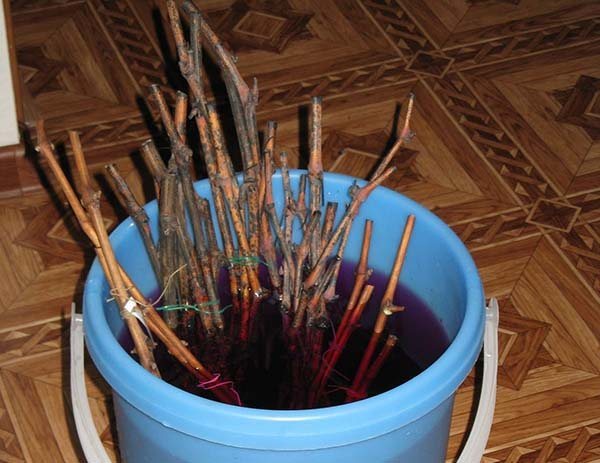

And already directly when cutting cuttings and updating slices you have to make sure that the wood inside is light green (= alive)rather than black or brown (= dry, dead).
- Slice.
By the way! A shank is usually called a shank, which has 3 well-developed buds (more precisely, an eye).
The vine, as a rule, is initially cut and laid for storage in a sufficiently long form (cuttings are made 60-80 cm long). In this form, cuttings are better stored, remain more viable and do not dry out, especially their ends.
What are requirements apply to the cutting, which can be put on germination, or rather, how it properly cut and prepare:
- Shaft length should be in order 15-25 centimeters, while he may have 2 to 3 eyes.
- Naturally, you need cut the cuttings themselves either just update all bottom cutsif they were short at once.
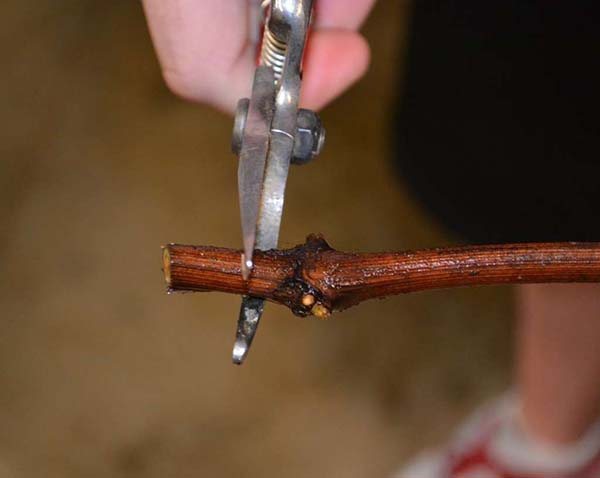

Slices must be smooth, in other words, good in advance sharpen your secateurs or knife.
Bottom cut it should be straight and be under the eye (stepping back 1 cm from it), but upper the cut should be oblique (pointed towards the kidney) and be above the eye (2-3 cm above it).
If you find it difficult to determine which is the top and which is the bottom, then here's a cheat sheet: the top is always slightly thinner than the bottom, and the eyes look exactly up.
- Further it is recommended cut off all lower eyes, they also say - to blind (you will only get rid of the real kidneys, there will be 2-4 more sleeping ones inside).
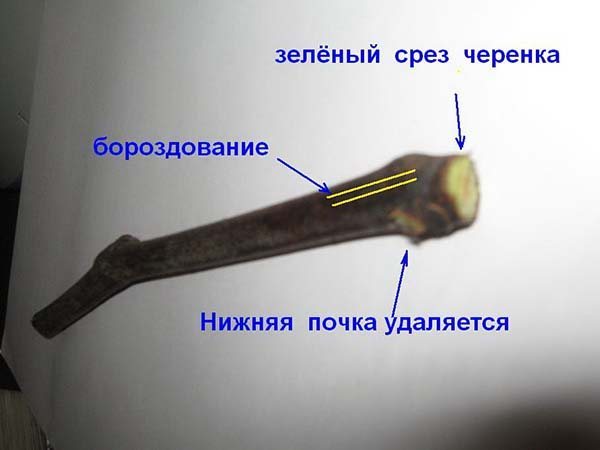

This is done so that they (lower buds) do not wake up during germination and do not take food from the upper ones, which should give shoots.
- If you have many different varieties, then it's time sign cuttings (for example, with a permanent marker at the top).
- Required soak, in other words, the shanks should swim in water for 1-2 days (it is advisable to use thawed, rain or at least settled water).
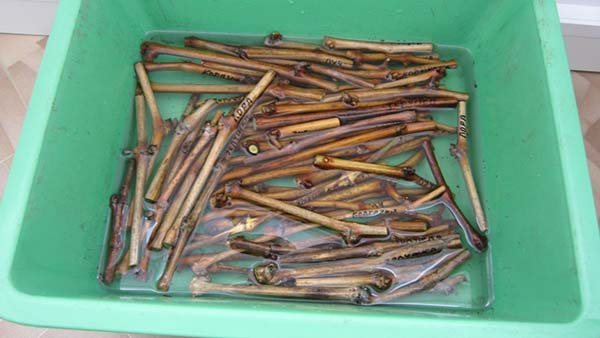

You can tie the shanks into a bunch or just throw them into a bucket (another suitable container). Or put the lower part (heel) in a container of water so that the cutting is 1 / 3-1 / 2 in water.
- Some growers additionally recommend (optional procedure) from above pour the cutting (upper part with eyes) with wax or paraffin (paraffin).
Waxing delays the germination of the eye for 5-7 days, so that at this time all the growth energy of the cutting is directed to the formation of roots.
- You can and even need to spend furrow - make 2-4 shallow (you need damage only the bark) longitudinal scratches (grooves).
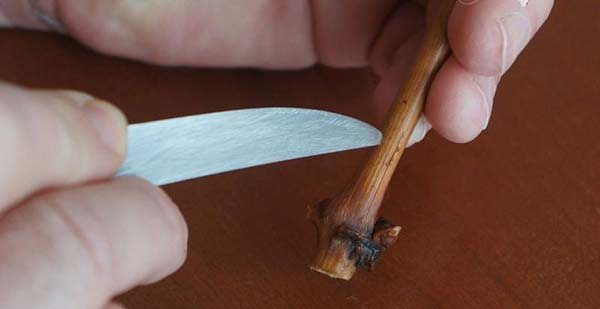

Rooting in the substrate
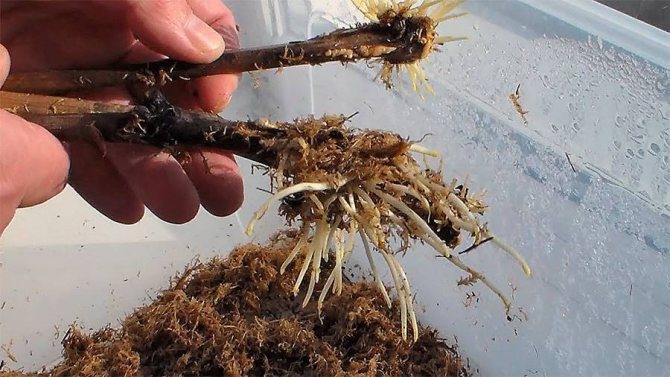

The lower cut is made straight, directly under the knot, and the upper one is 3-4 cm above the knot. This is followed by furrowing, which aims to induce an influx of hormones to the injured areas, which facilitates root formation. Cuttings can be treated with growth stimulants (root, heterauxin, sodium humate, etc.)
For rooting, it is best to use clear plastic drink bottles. Containers with cuttings are placed on a pallet, close to the light and the substrate is kept moist.
Pure coarse sawdust of coniferous species, coconut shavings, river sand, fine gravel are used as a substrate, forest sphagnum moss has proven itself well, cotton wool is also used. Small sawdust from under the saw is not used, because they quickly turn sour. Top dressing with fertilizers can be alternated with watering with a solution of sodium humate of a light straw color.
As soon as the cuttings take root, they are carefully shaken out and placed in other containers or a ground cuttings for growing. The new substrate should contain a large amount of river sand. Before planting rooted cuttings, the substrate is well watered with a pink solution of potassium permanganate.
It also shows a good way of horizontal rooting in the substrate - the lower part of the cutting is wrapped with a damp cloth or placed in moss or other substrate, then in a bag and put on a cabinet.
Material handling before winter storage
When preparing shoots for storage, follow this order:
- Remove leaves, mustaches, stepsons from the branch.
- If the cuttings are dry, soak them for 24 hours in water with the addition of honey.
- Make grooves on the bark of the shank for the germination of future additional roots.
- Treat with a root growth stimulant (eg heteroauxin).
- To disinfect the cuttings, immerse them in a 5% solution of ferrous sulfate for 30 minutes.
- Dry the blanks, tie them in bunches and sign the names of the varieties (or label them).
Ways of germinating grape cuttings
Important! Cuttings of different grape varieties begin their growing season at different times, so do not be surprised if one stem has already begun to germinate, and the other will still sit and not give roots, in other words, the rooting rate can be very different.
In a jar of water
- Pour 0.5-1.5 cm of water into a container (as a rule, a 0.5-1 liter can is used).
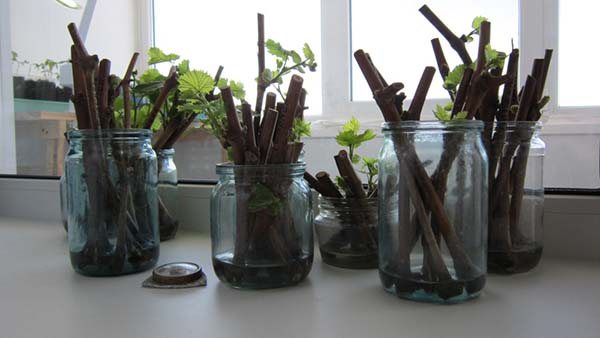

- Water it is advisable to use rain, better thawed or at least defended.
- The water temperature in the jar must be higher than the air temperature (up to +20 degrees - the lower, the better), but not higher than + 24-26 degrees (according to other sources, up to +28 degrees). Only in this case (the water temperature is higher than the ambient air), the roots are formed earlier than the vegetative part, otherwise leaves will first grow, which will inhibit the formation of roots!
By the way! It will be very useful to immediately do bank mark, in other words, set water level, which should be maintained: before bud break, it will take about 1 time in 2-3 days to add water, and when the leaves begin to grow, then 1 time in 1-2 days. And it's better not just add, but completely change the water
.
Advice! To change water less oftenyou can put in a jar a couple of pieces of charcoal (or an activated carbon tablet), and then a layer of cotton wool (for hygroscopicity)
.
- Place the cuttings in water. Moreover the stalk should be in water up to the middle of the knot (eye), i.e. maximum - 1-1.5 centimeters in water.
Worth knowing! For the development of roots, air is always needed, therefore, if the cuttings are half their length in water, then there can be no question of any formation of roots. After all, the roots are primarily formed at the water-air border.
- Itself put the container in a bright place - on the window, more precisely, on the windowsill, or even better - straight per battery and periodically do not forget to open the ventilation window (to lower the temperature).
- About after 3-4 weeks roots will begin to appear.
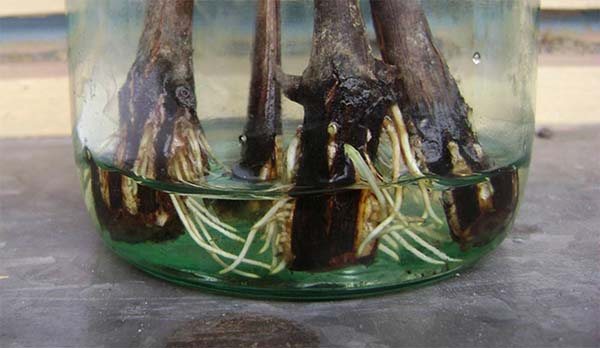

Note! But, often (especially if you do not comply with the above requirements), buds begin to swell and open before roots are formed... This is generally fine, but there are some things you can try:
- Alternatively, you can break the first swollen bud, and the spare one will begin to bloom only after a week.
- If you oversleep and leaves are already forming, then you can pinch one of them.
But! Some growers believe that the process of development of the root and leaf parts should go smoothly.
- When the roots will already be 0.5-1 cm each (maximum - up to 2 cm), cuttings sprouted in water can plant in the ground (in a transparent pot, bottle, greenhouse or directly into the open ground under a bottle).
Important! Do not overexpose, tk. the roots are very fragile, which means that the longer ones can simply break off during transplantation.
Video: germinating cuttings in water
By the way! The care of cuttings that are already being germinated in water is described in great detail and shown in this video:
Video: sprouting shanks in water - care rules
In a jar of water with aeration
In general, this method repeats and supplements the previous one, namely, for aeration (oxygen enrichment) of the water, the most ordinary compressor for an aquarium is used.
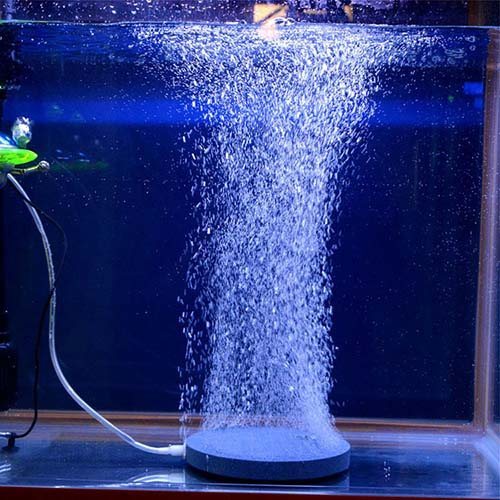

The method of rooting the shanks according to P.P. Radchevsky
Various methods are used to stimulate the formation of roots on the shanks.One of the simplest is the method of the professor of the Kuban Agrarian University Pyotr Radchevsky.
Rooting according to Radchevsky is done as follows:
- One-liter jars are filled with 3 cm of soft filtered water.
- The shafts prepared for rooting are placed in water. The top updated slice must be waxed again.
- Banks are placed on a warm light windowsill.
- Water, if necessary, is added without going over the three-centimeter mark. If the windowsill is hot, it is better to open the window slightly so that the upper part of the cuttings is cool. When doing this, make sure that the water remains warm.
- When the roots reach a length of 2-3 mm, the shanks are planted in glasses with soil.
The advantages of the Radchevsky method are simplicity and efficiency. The rooting rate is high and the seedlings are strong. The disadvantage is excessive fragility of the roots.
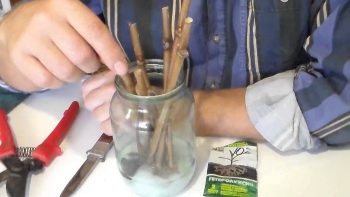

In the water for rooting according to Radchevsky, you can add a drug to stimulate root formation.
Further cultivation of germinated grape cuttings
With grape cuttings that have sprouted roots, you can do the following:
- plant in pots for further rooting and their transformation into full-fledged vegetative seedlings;
- plant immediately in a greenhouse or open ground.
Planting cuttings in pots at home
Planting capacity should be high enough - 30-40 cm, i.e. a 1-1.5 liter cut plastic bottle is ideal.
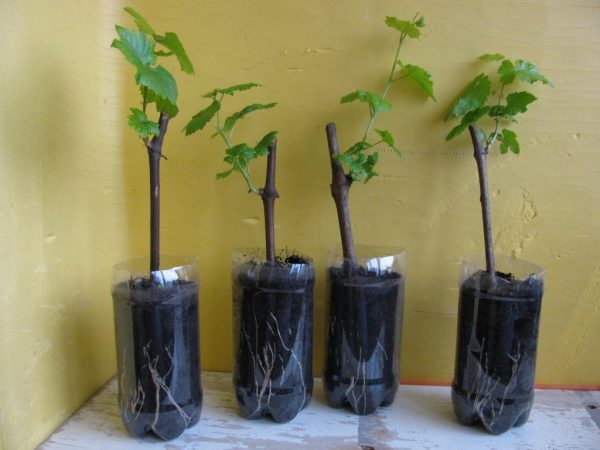

At the bottom, you should definitely do drainage holesso that excess moisture comes out, otherwise the stalk may rot.
Advice! In addition to the drainage holes at the bottom, you should also make small side holes.
Remember! Moisture stagnation threatens the most negative consequences for the roots.
Soil mix for transplanting by cuttings with roots, there must be loose. You can of course take and mix peat, humus, turf soil and sand in equal parts (or as an option - black soil, humus, sand and sawdust), but it is much easier to use any universal primer and loosen it with the same perlite.
You can also use soil with vermicompost and forest land (it is already loose, but sour, so you should deacidify it by adding a little wood ash).
It is advisable to ignite the soil mixture itself, in order to get rid of all possible fungal diseases, namely, it must be heated in the oven for 1.5-2 hours at a temperature of 180-200 degrees.
Step-by-step instructions for planting a sprouted cuttings in a pot:
Care of planted seedlings
During the growing season, feed with a diluted mullein 3-4 times (1 liter of fresh mullein per bucket of water). Of mineral fertilizers, it is better to use Kemira or Harvest, but very little, so as not to cause rapid plant growth. In early August, watering is reduced, and no fertilizing is given at all, so that the vine ripens better.
When 9-10 leaves appear on the plant, its top must be pinched to stop growth and better ripening of the shoot and buds. During growth, such pinching is done 2-3 times. To prevent the growing shoot from falling, it is tied to a vertical support. This can be a thin wooden pole, 6 mm wire, etc. All stepchildren, except for one, the lowest, should be broken off at the very beginning of their growth. Over the summer, such a plant grows up to 1.5-2.0 m and has an excellent root lobe.
Saplings grown in this way root perfectly before winter and easily tolerate wintering with a small shelter.
Place and condition of storage of shanks
Cuttings are stored at home at a temperature of +3 - + 5 ° C. Bundles can be stored in plastic bags in damp sawdust or wrapped in a damp cloth (if you plan to put them in the refrigerator). In order to provide access to the air shoots, do not tie the packaging tightly. You can put the cuttings in wooden boxes with damp sand. It is convenient to store the workpieces in the cellar, basement (especially large quantities) or on the shelves of the refrigerator (not in the freezer!). It is important to slightly dampen the sawdust or cloth from time to time.They should not be wet. A too humid environment can lead to rotting of the shoots.
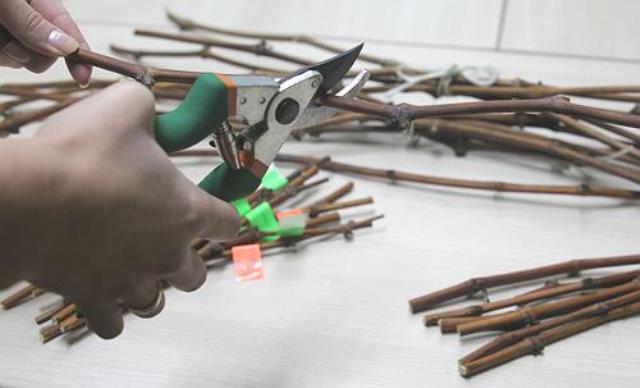

Timing of rooting cuttings
When can you carry out the procedure for rooting cuttings? The rooting time depends on the climatic conditions of the region and the time of planting the prepared seedling in the ground. At home, it is necessary to start the process of rooting grape cuttings in the spring 3-4 weeks before planting. By this time, the seedling will have formed a sufficiently strong root system and the leaves will begin to sprout.
In the southern regions, you should start in late January or early February. In regions with colder climates - late February or mid-March. You can also rooting grape cuttings in the fall, but only in the southern regions. In a cold winter, a young and fragile stalk may simply freeze.
When and how to plant vegetative cuttings (seedlings) of grapes in open ground
A high-quality vegetative stalk (more precisely, already a seedling) of grapes must have the following characteristics:
- have at least 7-8 leaves;
- the length of green shoots should be at least 15-20 cm;
- have a developed root system (at least a 1-liter container in which the cutting was grown must be completely filled with its roots).
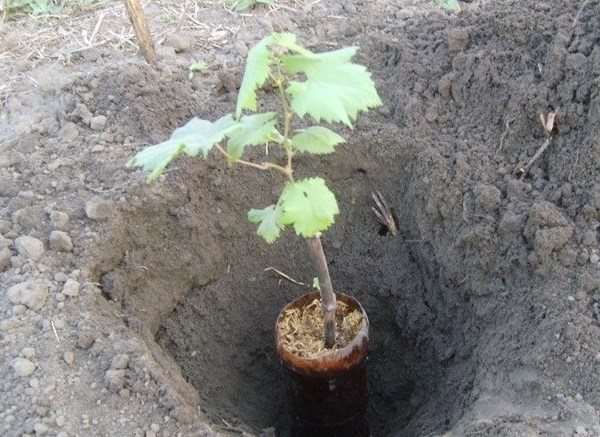

In no case you cannot immediately take out a young green seedling (formerly a cutting) outside and plant it in the ground, otherwise he will simply die. Plant need to necessarily temper, and doing it gradually: first, take out for 20 minutes, then 40 and so on for 7-10 days. During this time, the seedling will pass adaptation to new conditions.
Concerning timing, then as mentioned earlier, you can plant when the ground (to the planting depth) will warm up to +10 degrees and the threat of return spring frosts will pass. IN Depending on the region, this happens at different times:
- So, in the south of Russia can be planted starting from mid to late April.
- In the middle lane (Moscow region) — in the second half or end of May.
The planting itself is standard, like that of a seedling with a closed root system, in other words, you take and transfer it to a pre-prepared planting pit with a lump of earth, carefully, in no case removing an earthen lump from the roots.
Note! The site already has a detailed article about the spring planting of grape seedlings.
Video: planting a vegetative seedling in open ground
Video: planting vegetative grape seedlings in the ground (according to Pusenko)
The time of the preparation of the shanks
Having made the decision to carry out grape cuttings, correctly determine the time for harvesting shoots. Cutting of the planting material takes place in the fall at different times for different climatic zones. The selection time also depends on the variety of culture. Roughly the procurement process takes place at the end of autumn after the harvest and the end of the plant's growing season. When the grapes shed their leaves, you can start cutting the shanks. In early grape varieties, the growing season ends earlier (starting at the end of July). You can cut the material at an earlier date. Late crop varieties may not shed their foliage until the end of November. The blanks should be done before the first frost. Wild grapes are planted by cuttings in the spring, between May and June.


Pruning cuttings at home
Cuttings for planting and germination are cut in the fall. At this time, only healthy branches remain on the bush, and all the weakened ones die off. You will need a pruner and a solution of copper sulfate. Cuttings are dipped into it after cutting. Vines with the largest bunches of grapes are the best planting material.
Cuttings are germinated and planted according to a clear algorithm:
- The cuttings are cut when there is no foliage left on the bush.
- Choose a vine as straight as possible, 0.7-1.2 cm in diameter.
- Choose a branch of medium length, unnecessary bends are not welcome. Each should have 2-3 buds.The cut is made at an angle of 45 ° at a distance of 3 cm from the first kidney.
- Cuttings are cut at positive temperatures. If frosts have begun, cuttings should be postponed until next year.

